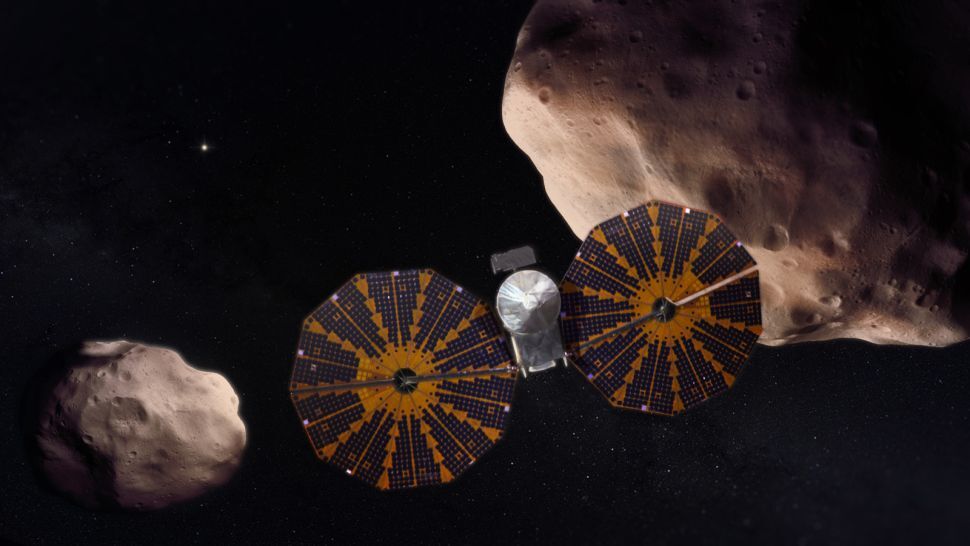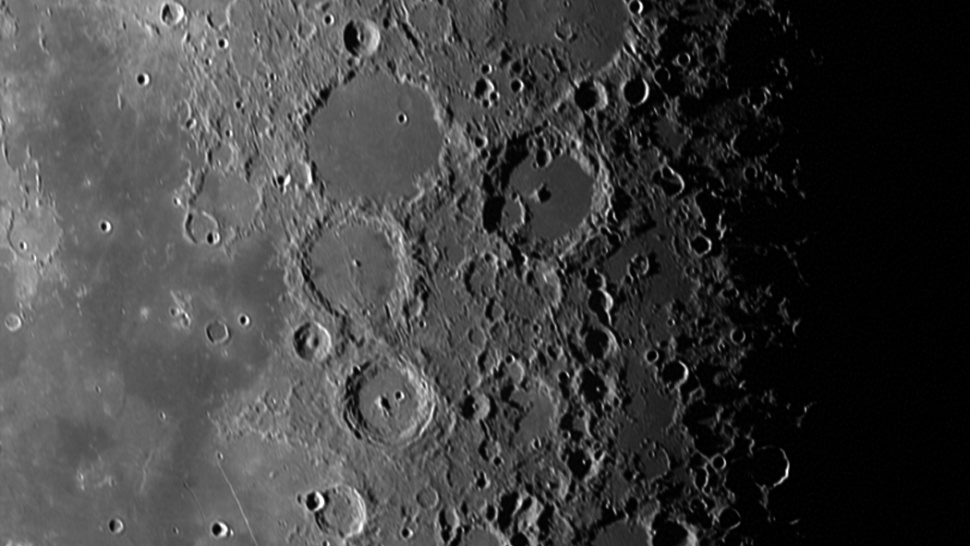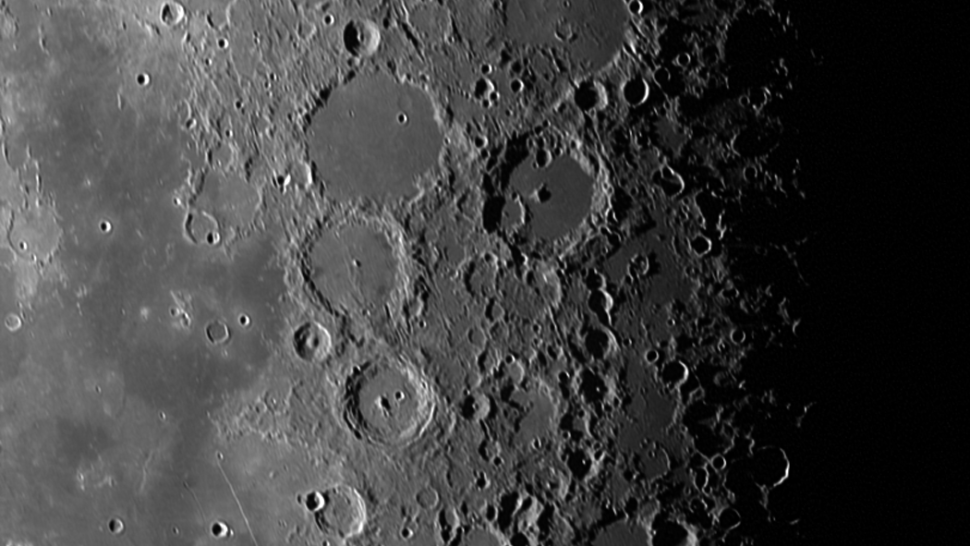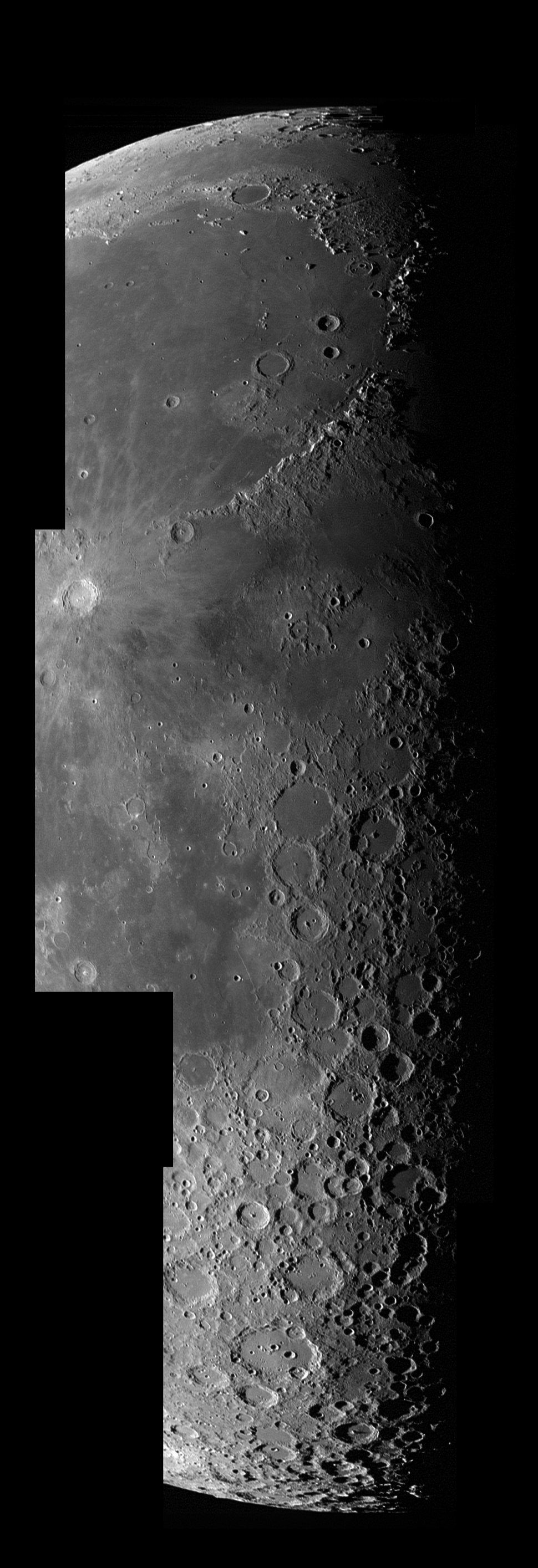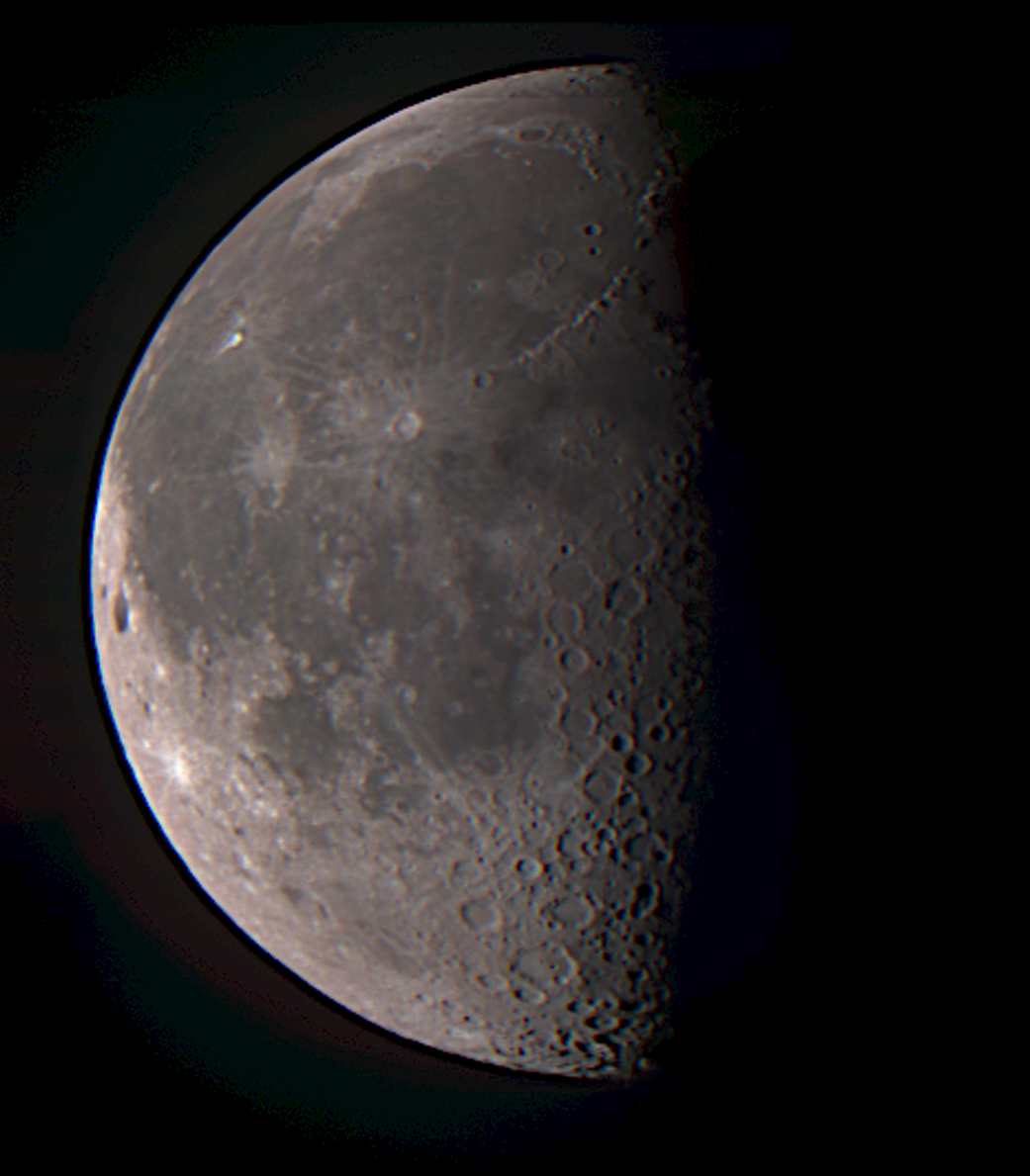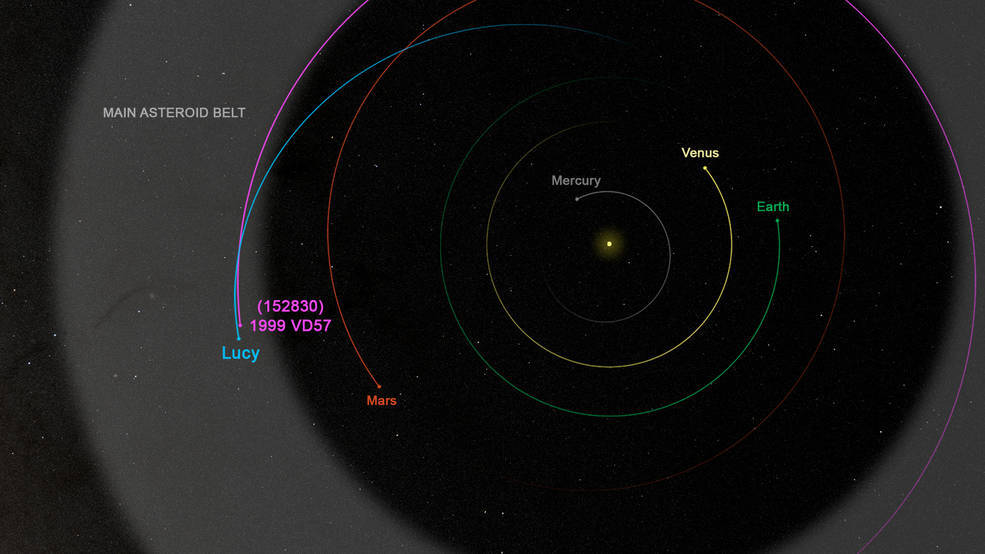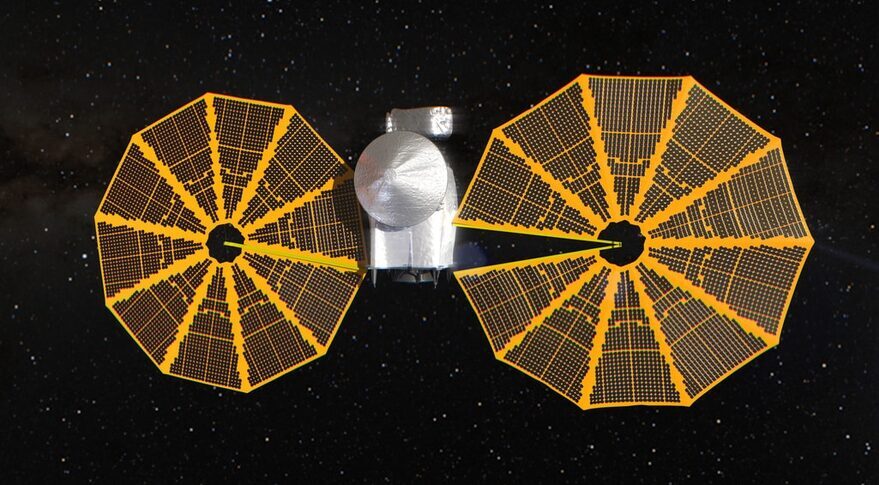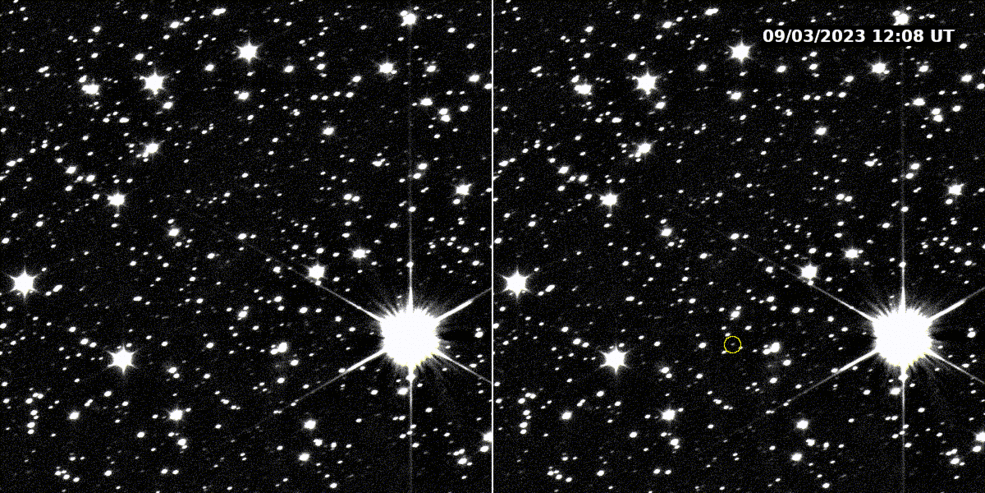NASA's asteroid-touring mission has picked up a ninth target.
In preparation for the Lucy mission to explore a distant class of asteroids called the Trojans, astronomers have been monitoring the targeted space rocks. One day in March, mission personnel gathered 26 different teams from around the world to watch one of those asteroids, 17-mile-wide (27 kilometers) Polymele, appear to pass in front of a star in what scientists call an occultation.
By comparing observations from many different locations on Earth, scientists can precisely measure the shadow an asteroid casts on a star during such an event, allowing them to precisely study the size and shape of the space rock. But during the March observations, which were briefly reported at the time, two of the participating teams saw something different.
"We were thrilled that 14 teams reported observing the star blink out as it passed behind the asteroid, but as we analyzed the data, we saw that two of the observations were not like the others," Marc Buie, a Lucy scientist at the Southwest Research Institute in Colorado, said in a statement.
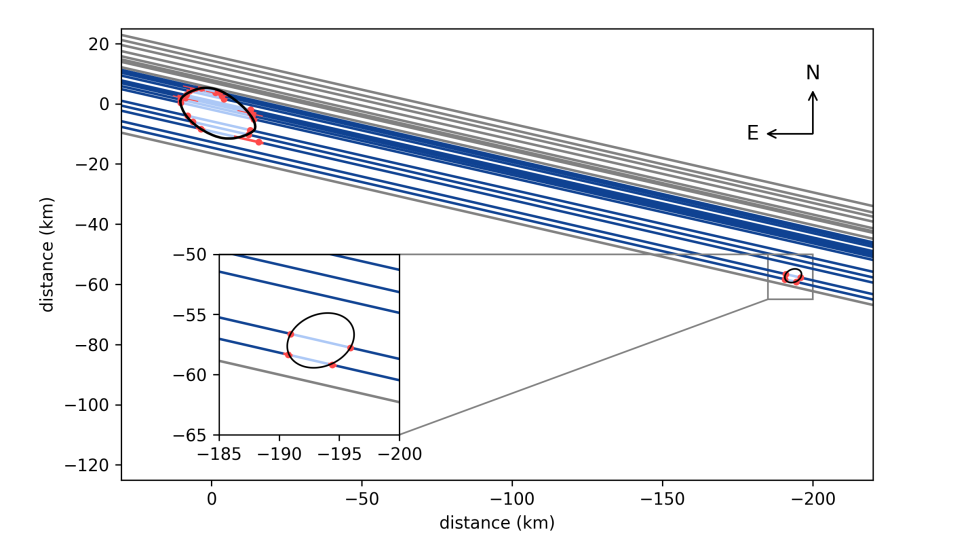
A diagram of occultation observations show Polymele in the upper left and its newly discovered satellite on the right.
Astronomers reviewing the data concluded that those observations indicated a previously undiscovered space rock orbiting Polymele about 125 miles (200 km) away. "It had to be a satellite," Buie said. The scientists could even determine the newly found asteroid's size: about 3 miles (5 km) across.
The still-unnamed asteroid has since been added to Lucy's ambitious itinerary of space rock flybys. The new detection is the second time that scientists have spotted an extra satellite; in 2020, researchers announced they had spotted a satellite orbiting Eurybates, which Lucy will fly past just a month beforePolymele.
Like most of Lucy's destinations, Polymele, is a Trojan: an asteroid that drifts around the sun in about the same orbit as Jupiter due to the large gas giant's immense gravitational pull. Scientists believe that these "fossil" rocks are the rubble left over from planet formation and could therefore teach us about the early days of our solar system.
About the newly discovered asteroid's name: while some of the discovery team have reportedly nicknamed it "Shaun" after the animated sheep, it won't have an official name until astronomers can confirm the characteristics of its orbit. That likely won't happen any time soon because Polymele's satellite isn't discernible by current Earth-based telescopes. So, unless astronomers get lucky with a future occultation, they may have to wait until Lucy itself swings past the asteroid, scheduled to occur in 2027.
"Lucy’s tagline started out: 12 years, seven asteroids, one spacecraft," NASA's Lucy program scientist, Tom Statler, said in the statement. "We keep having to change the tagline for this mission, but that's a good problem to have."
Quelle: SC
----
Update: 17.10.2022
.
NASA’s Lucy Spacecraft Prepares to Swing by Earth
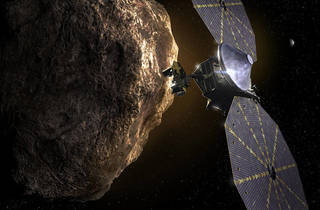
On Oct. 16, at 7:04 a.m. EDT, NASA’s Lucy spacecraft, the first mission to the Jupiter Trojan asteroids, will skim the Earth’s atmosphere, passing a mere 220 miles (350 kilometers) above the surface. By sling-shotting past Earth on the first anniversary of its launch, Lucy will gain some of the orbital energy it needs to travel to this never-before-visited population of asteroids.
The Trojan asteroids are trapped in orbits around the Sun at the same distance as Jupiter, either far ahead of or behind the giant planet. Lucy is currently one year into a twelve-year voyage. This gravity assist will place Lucy on a new trajectory for a two-year orbit, at which time it will return to Earth for a second gravity assist. This second assist will give Lucy the energy it needs to cross the main asteroid belt, where it will observe asteroid Donaldjohanson, and then travel into the leading Trojan asteroid swarm. There, Lucy will fly past six Trojan asteroids: Eurybates and its satellite Queta, Polymele and its yet unnamed satellite, Leucus, and Orus. Lucy will then return to Earth for a third gravity assist in 2030 to re-target the spacecraft for a rendezvous with the Patroclus-Menoetius binary asteroid pair in the trailing Trojan asteroid swarm.
For this first gravity assist, Lucy will appear to approach Earth from the direction of the Sun. While this means that observers on Earth will not be able to see Lucy in the days before the event, Lucy will be able to take images of the nearly full Earth and Moon. Mission scientists will use these images to calibrate the instruments.
Lucy’s trajectory will bring the spacecraft very close to Earth, lower even than the International Space Station, which means that Lucy will pass through a region full of earth-orbiting satellites and debris. To ensure the safety of the spacecraft, NASA developed procedures to anticipate any potential hazard and, if needed, to execute a small maneuver to avoid a collision.
“The Lucy team has prepared two different maneuvers,” says Coralie Adam, Lucy deputy navigation team chief from KinetX Aerospace in Simi Valley, California. “If the team detects that Lucy is at risk of colliding with a satellite or piece of debris, then--12 hours before the closest approach to Earth --the spacecraft will execute one of these, altering the time of closest approach by either two or four seconds. This is a small correction, but it is enough to avoid a potentially catastrophic collision.”
Lucy will be passing the Earth at such a low altitude that the team had to include the effect of atmospheric drag when designing this flyby. Lucy’s large solar arrays increase this effect.
“In the original plan, Lucy was actually going to pass about 30 miles closer to the Earth,” says Rich Burns, Lucy project manager at NASA’s Goddard Space Flight Center in Greenbelt, Maryland. “However, when it became clear that we might have to execute this flyby with one of the solar arrays unlatched, we chose to use a bit of our fuel reserves so that the spacecraft passes the Earth at a slightly higher altitude, reducing the disturbance from the atmospheric drag on the spacecraft’s solar arrays.”
At around 6:55 a.m. EDT, Lucy will first be visible to observers on the ground in Western Australia (6:55 p.m. for those observers). Lucy will quickly pass overhead, clearly visible to the naked eye for a few minutes before disappearing at 7:02 a.m. EDT as the spacecraft passes into the Earth’s shadow. Lucy will continue over the Pacific Ocean in darkness and emerge from the Earth’s shadow at 7:26 a.m. EDT. If the clouds cooperate, sky watchers in the western United States should be able to get a view of Lucy with the aid of binoculars.
“The last time we saw the spacecraft, it was being enclosed in the payload fairing in Florida,” said Hal Levison, Lucy principal investigator at the Southwest Research Institute (SwRI) Boulder, Colorado office. “It is exciting that we will be able to stand here in Colorado and see the spacecraft again. And this time Lucy will be in the sky.”
Lucy will then rapidly recede from the Earth’s vicinity, passing by the Moon and taking a few more calibration images before continuing out into interplanetary space.
“I’m especially excited by the final few images that Lucy will take of the Moon,” said John Spencer, acting deputy project scientist at SwRI. “Counting craters to understand the collisional history of the Trojan asteroids is key to the science that Lucy will carry out, and this will be the first opportunity to calibrate Lucy’s ability to detect craters by comparing it to previous observations of the Moon by other space missions.”
The public is invited to join the #WaveToLucy social media campaign by posting images of themselves waving towards the spacecraft and tagging the @NASASolarSystem account. Additionally, if you are in an area where Lucy will be visible, take a photograph of Lucy and post it to social media with the #SpotTheSpacecraft hashtag. Instructions for observing Lucy from your location are available here.
Hal Levison of Southwest Research Institute (SwRI), in the Boulder Colorado office is the principal investigator. SwRI, headquartered in San Antonio, also leads the science team and the mission’s science observation planning and data processing. NASA Goddard provides overall mission management, systems engineering and the safety and mission assurance for Lucy. Lockheed Martin Space in Littleton, Colorado built the spacecraft, principally designed the orbital trajectory and is providing flight operations. Goddard and KinetX Aerospace are responsible for navigating the Lucy spacecraft. Lucy is the thirteenth mission in NASA’s Discovery Program, which is managed by NASA’s Marshall Space Flight Center in Huntsville, Alabama.
Quelle: NASA
+++
Mission engineers will track NASA’s Lucy spacecraft nonstop as it prepares to swoop near Earth on Oct. 16 to use this planet’s gravity to set itself on a course toward the Jupiter Trojan asteroids.
But they also will be closely tracking something else: more than 47,000 satellites, debris, and other objects circling our planet. A greater than 1-10,000 chance that Lucy will collide with one of these objects will require mission engineers to slightly adjust the spacecraft’s trajectory.
Although an adjustment is unlikely, and collisions are rare, the chances are increasing as the number of objects in Earth’s orbit grows, NASA experts say.
The International Space Station, for instance, has maneuvered out of the way of space debris 31 times since 1999, including three times since 2020.
“Low-Earth orbit is getting more crowded, so that has to be part of the consideration nowadays, especially for missions that fly low, like Lucy,” said Dr. Dolan Highsmith, chief engineer for the Conjunction Assessment Risk Analysis group at NASA’s Goddard Space Flight Center in Greenbelt, Maryland. The group determines the probabilities of collisions between NASA’s robotic spacecraft and Earth-orbiting objects. NASA’s Johnson Space Center in Houston does the same for crewed spacecraft, such as the space station.
Launched on Oct. 16, 2021, Lucy is on a 12-year-journey to study multiple Trojan asteroids up close. It’ll be the first spacecraft to visit these remnants from the early solar system, helping scientists hone their theories on how the planets formed 4.5 billion years ago and why they ended up in their current configuration.
Read more details about Lucy’s Oct. 16 gravity assist and future trajectory.
But Lucy has a long way to go before it arrives at the Trojans in 2027. The upcoming gravity assist is one of three the spacecraft will rely on to catapult itself to its deep-space targets.
When Lucy comes nearest to Earth for its first gravity assist it will cruise 220 miles (350 km) above the surface. That’s lower than the altitude of the space station and low enough that the spacecraft will be visible with the naked eye from western Australia for a few minutes starting at 6:55 p.m. local time (10:55 UTC). On its way down, Lucy will fly through the most crowded layer of Earth’s orbit, which is monitored by the U.S. Space Force’s 18th Space Control Squadron. The squadron helps NASA identify close approaches.
Engineers began collision analysis for Lucy a week before the spacecraft’s Earth approach. Starting the process any earlier would render collision predictions futile, Highsmith said: “The further you're predicting into the future, the more uncertain you are about where an object is going to be.”
Determining the positions of spacecraft, plus orbiting satellites and debris, is challenging, particularly when trying to anticipate the future. Largely that’s because the Sun plays a major role in pulling or pushing objects around, and future solar activity is hard to predict. For example, the Sun’s activity — how much plasma and radiation it shoots out — affects atmosphere density, and thus how much friction will tug on a spacecraft and slow it down.
So the closer the collision assessment is to the Earth flyby time, the better. NASA sends Lucy’s whereabouts to the Space Force squadron daily. If the squadron determines that Lucy could intersect with something, Highsmith’s group will calculate the probability of a collision and work with the mission team to move the spacecraft, if necessary.
“With such a high value mission, you really need to make sure that you have the capability, in case it's a bad day, to get out of the way,” Highsmith said.
Lucy navigation engineers have two maneuver options ready in case the spacecraft needs to avoid an object. Both maneuvers require engine burns to speed up the spacecraft, which is traveling about 8 miles (12 km) per second. Each maneuver can move Lucy’s closest approach to Earth up by 2 seconds or 4 seconds, respectively.
“That's enough to avoid any one thing that could be in the way,” said Kevin E. Berry, Lucy’s flight dynamics team lead from NASA Goddard.
Quelle: NASA
----
Update: 22.10.2022
.
Lucy completes its first Earth gravity assist after a year in space
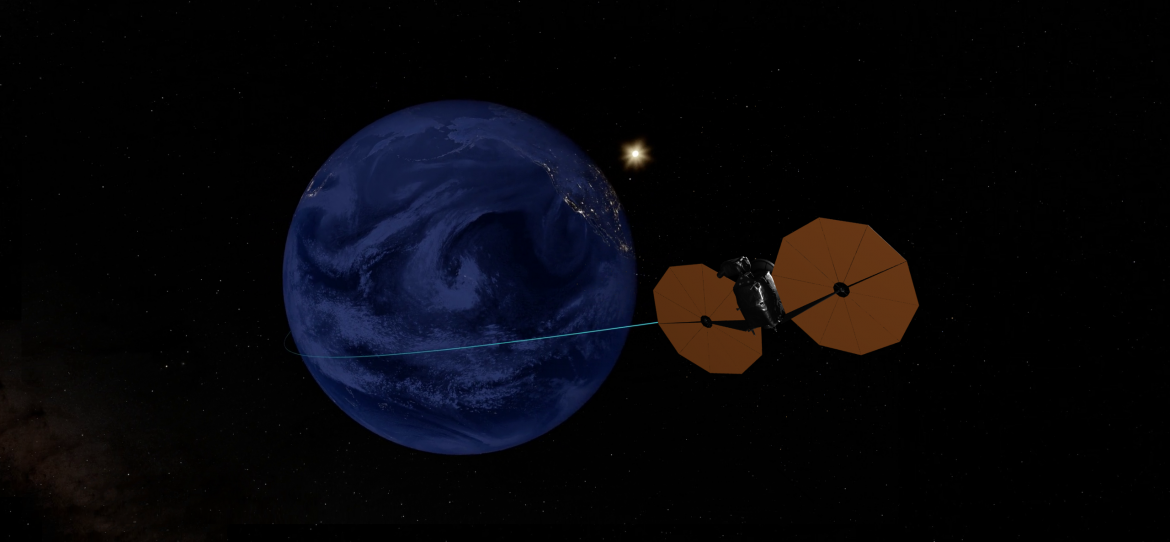
A year after its launch, NASA’s Jupiter Trojan asteroid explorer Lucy has completed its first of multiple Earth gravity assists on its journey to explore nine asteroids. Lucy is a first-of-its-kind mission to visit several Trojan asteroids in Jupiter’s L4 and L5 Lagrange points. The mission’s closest approach to Earth occurred on Oct. 16 at 7:04 AM EDT (11:04 UTC).
Lucy Instruments and Flyby
Since its launch on Oct. 16, 2021, Lucy has been operating in cruise mode in a heliocentric orbit around the Sun. The cruise mode allows Lucy substantial autonomy as it coasts between significant events. The three primary science instruments are inactive during cruise mode; however, in November 2021, they were turned on for system checkouts. Mission controllers then turned them back off after the checkouts.
To ensure a close flyby of Earth, Lucy completed multiple correction maneuvers and minor burns to place the spacecraft on a trajectory as close to Earth as possible. In preparation for the flyby, Lucy completed a correction maneuver on June 21.
Since June, Lucy has been in limited communications caused by the thermal conditions of its position relative to Earth and the Sun. Because of this, its high-gain antenna is out of commission, and the craft currently talks to Earth via its low-gain antenna. With the flyby complete, Lucy will soon return to using its high-gain antenna.
A month before the flyby, Lucy was ~14.5 million kilometers from Earth. On Sept. 26, Lucy was 10.4 million kilometers away and activated its Long Range Reconnaissance Imager (L’LORRI) to begin observations of the Didymos/Dimophos binary asteroid system. Lucy started watching the system to capture imagery of NASA’s Double Asteroid Redirection Test (DART) impact of Dimophos—which successfully changed the orbital period of the small asteroid by 32 minutes.
DART featured a camera system named Didymos Reconnaissance and Asteroid Camera for Optical navigation (DRACO). Both DRACO and L’LORRI were initially developed from the LORRI camera onboard New Horizons. Lucy successfully observed DART’s impact and will transmit its imagery in the coming days.
Lucy features three instruments to conduct observations throughout the mission.
L’LORRI is a high-spatial-resolution monochrome visible imager and will provide highly detailed images of the Trojan asteroid surfaces. The John Hopkins University Applied Physics Laboratory provided the imager for Lucy.
Similarly, the spacecraft’s Thermal Emission Spectrometer (L’TES) will detect radiation emitting from the Trojan asteroids. It was developed from OTES (OSIRIS-REx Thermal Emission Spectrometer), which was used on OSIRIS-REx, and the EMIRS (Emirates Mars Infrared Spectrometer), which flew on the Al-Amal Mars mission. Arizona State University built the spectrometer for Lucy.
The third and final instrument is L’Ralph, composed of two sub-instruments: the Multispectral Visible Imaging Camera (MVIC)—a visible-light imager—and the Linear Etalon Imaging Spectral Array (LEISA)—an infrared spectrometer. L’Ralph is based on the Ralph instrument flown onboard New Horizons and will be used to measure silicates, ice, and organics on the surface of the Trojan asteroids. The instrument was built by the Goddard Space Flight Center.
The high-gain antenna and radio telecommunications hardware will measure doppler shifts, helping to determine the mass of the Trojans.
Lockheed Martin built the spacecraft, incorporating the lessons learned from New Horizons and OSIRIS-REx—the latter of which the company also made.

Lucy before it was encapsulated in Atlas V’s 4.2-meter fairing. (Credit: NASA)
This calibration will ensure the spacecraft can get as precise science as possible during its flybys. During its Earth flyby, Lucy attempted to take photos of Ethiopia, where the Lucy fossil—the spacecraft’s namesake—was discovered.
At its closest approach, Lucy came just 351 kilometers from the surface of Earth, which is closer than most orbiting spacecraft—including the ISS. As it was so close to Earth, this made the spacecraft experience slight atmospheric drag that the teams had to compensate for.
“In the original plan, Lucy was actually going to pass about 30 miles (48 km) closer to the Earth,” said Rich Burns, Lucy’s project manager at NASA’s Goddard Space Flight Center in Greenbelt, Maryland. “However, when it became clear that we might have to execute this flyby with one of the solar arrays unlatched, we chose to use a bit of our fuel reserves so that the spacecraft passes the Earth at a slightly higher altitude, reducing the disturbance from the atmospheric drag on the spacecraft’s solar arrays.”
Twelve hours before the gravity assist, Lucy could conduct a minor correction burn in case of a risk of collision with orbital debris. As Lucy approached Earth, there was a risk of collision with large amounts of debris and objects in orbit around the planet. This correction maneuver would have altered the close approach by a few seconds. While only a few seconds difference, it would have been enough to avoid a collision. To prepare for the possible burn, NASA scanned Lucy’s path ten days before the gravity assist to check for any potential impacts requiring the burn.
Once retreating from Earth, Lucy gathered a few more calibration images before leaving Earth’s sphere of influence.
As Earth and Jupiter are the closest the two have been in decades, Lucy is as close to Jupiter now as it will ever get. As Jupiter’s orbit is so large, the distance from the planet to its Trojan asteroids is so significant that Lucy—at the Trojans—will be further from Jupiter than during the gravity assist.
The purpose of a gravity assist is to use a planetary body’s gravitational force to alter a spacecraft’s trajectory. When performing a gravity assist, the spacecraft enters a planetary body’s sphere of influence to change its velocity using the planet’s gravity. Lucy used Earth’s gravity to gain speed, boosting the highest point—or aphelion—of its orbit around the Sun.
The gravity assist with Earth changed its aphelion to pass the orbit of Mars. With this, the orbital period for Lucy increased to two years. After completing a single orbit, Lucy will conduct a second Earth gravity assist to provide the energy needed to have its aphelion reach the orbit of Jupiter.
Lucy Update
Since launch, Lucy has operated flawlessly while in heliocentric orbit—despite the issue with one of its two solar arrays.
With a lanyard initially failing to spool and latch the solar array, NASA spooled the lanyard over multiple days to increase the stability and tension of the array—along with its power generation. The solar array is now deployed to around 353-357 of its planned 360 degrees, and the teams are confident in the array’s ability to complete Lucy’s mission in its current state. With the gravity assist complete, NASA and the teams will determine if they will continue with further spooling operations in the future.
The Lucy teams have also continued to observe the Trojan asteroids to understand the targets fully.
In August 2022, the Lucy team announced the discovery of a moon around one of its targets, Polymele. Lucy’s team discovered the moon on March 27. As part of a routine observation, Polymele passed in front of a star, blocking—or occulting—the star’s light. With multiple astronomers situated across the path of the occultation, this allowed the teams to measure the size, location, and shape of Polymele with impressive precision as the star’s light was obstructed or dimmed.

A graphic showing the distance and artist impression of Polymele’s Moon. (Credit: NASA’s Goddard Space Flight Center)
Teams were surprised, however, when multiple observers noticed the star blink twice as the asteroid passed by. The unexpected observations detected an object 200 km away from Polymele. Using the same occultation data, the teams found the moon to be 5 km in diameter, but 27 km long along its widest axis. Teams will not give a name to the moon until its orbit is better determined by either Lucy or a ground-based occultation observation.
This is not the first time the Lucy teams have discovered a moon around one of the asteroid targets. The Lucy teams previously used the Hubble Space Telescope to observe the targets for an unexpected binary pair. An undetected secondary asteroid could confuse the targeting system—or even risk losing the spacecraft. While looking at images from 2018, the teams discovered a moon around Eurybates. With other observations in early 2020, they confirmed the moon’s existence and named it Queta.
Queta is estimated to be less than 1 km in diameter. The discovery of the two moons increased the mission’s target count from seven to nine.
Lucy’s Future—A Flyby Frenzy
Lucy’s second gravity assist with Earth will occur on Dec. 13, 2024. The second gravity assist will begin the spacecraft’s multi-year journey to fly past multiple asteroids. Just five months after the second gravity assist, Lucy will fly by asteroid 52246 Donaldjohanson, located in the main asteroid belt between Jupiter and Mars. The probe will use Donaldjohanson as a rehearsal before reaching the Trojan asteroids.
While only a trial, this flyby will provide the teams with valuable data on C-type asteroids. Measuring only 4 km in diameter, it is one of the smallest objects Lucy will visit. The object is identified to be a fragment of a massive collision from 130 million years ago, which produced the Eriogone family of asteroids.
After flying past Donaldjohanson, Lucy will continue to the L4 Trojan swarm “in front” of Jupiter. Known as the “Greek camp,” the L4 Trojan asteroids congregate around the “leading” Lagrange point, creating a swarm of asteroids.
Lucy’s first flyby of the Trojan asteroids will take place on Aug. 12, 2027, visiting 3548 Eurybates. Eurybates is another C-type asteroid, like Donaldjohanson, but somehow ended up much further from the Sun than its sibling. Eurybates is 64 km in diameter and originated from the same collision as Donaldjohanson. Lucy will visit the asteroid and its moon, Queta, to understand more about how C-type asteroids form, why Eurybates ended up in the Trojan swarm, and more.
A month later, on Sept. 15, Lucy will fly by 15094 Polymele. As a P-type asteroid, this will be the first time a spacecraft flies past a member of the dark, reddish class of asteroid that could be rich in organics. Scientists believe Polymele formed from a collisional fragment of a larger asteroid; Polymele will be compared to other P-type asteroids to determine why it is smaller than others of the same type. Polymele also is accompanied by a moon; Lucy’s flyby will allow closer-up studies of the body to determine its orbit around Polymele.
After a short seven-month coast, Lucy will reach 11351 Leucus, a D-type asteroid. Unlike some other asteroids, Leucus rotates, having a 446-hour day. This rotation gives the surface of Leucus different heating over time compared to other asteroids. Studying Leucus will help scientists understand the composition and formation of D-class asteroids. During observations of the asteroid, its brightness varies from Earth’s perspective, suggesting it has an elongated shape. Leucus is approximately 40 km in diameter.
The final object Lucy will explore in the Greek L4 swarm is the D-type asteroid 21900 Orus. Orus is a larger asteroid, at 51 km in diameter, and can be compared to the smaller Lueucus. While the two are both D-types, Orus has a dark, red surface—much like Eurybates. Lucy will fly by Orus on Nov. 11, 2028.
After completing its flyby of the Greek L4 swarm, Lucy will then begin a return to the inner solar system for its third and final Earth gravity assist. On Dec. 26, 2030, the spacecraft will complete its gravity assist of Earth to aim for the L5 set of Trojan asteroids, also known as the “Trojan camp.”
As the last two targets for Lucy, 617 Patroclus and Menoetius are binary P-type asteroids in the L5 swarm. With diameters of 113 and 104 km, respectively, the two are in a relativity high-inclination heliocentric orbit at 22 degrees. Scientists believe the two may be primordial asteroids originating from the early solar system. Lucy will fly past the pair on March 3, 2033, completing its 12-year primary mission.
During each flyby, the spacecraft will pass 400 to 965 km away from each asteroid, allowing for detailed surface observations. Studying these asteroids will allow scientists to better understand how the solar system was formed.
While the primary mission will be over after its final flyby, Lucy’s exploration will not be finished. In its final orbit, Lucy can continue exploring the trojan asteroids for many more years. NASA will most likely continue its mission until it runs out of fuel—or the agency loses communication with the spacecraft. Once that happens, Lucy will continue on a similar orbit for thousands or even millions of years.
In the future, Lucy’s sister mission, Psyche, will explore the metal asteroid 16 Psyche. Psyche will start its mission once its next launch window opens no earlier than 2023.
Quelle: NS
----
Update: 27.10.2022
.
NASA's Lucy Spacecraft Captures Images of Earth, Moon Ahead of Gravity Assist
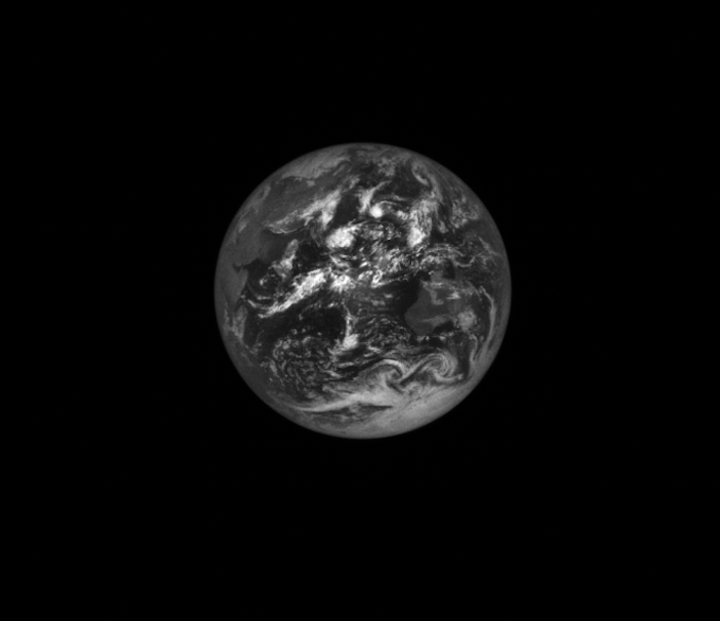
NASA’s Lucy spacecraft captured this image (which has been cropped) of the Earth on Oct 15, 2022, as a part of an instrument calibration sequence at a distance of 380,000 miles (620,000 km). The upper left of the image includes a view of Hadar, Ethiopia, home to the 3.2 million-year-old human ancestor fossil for which the spacecraft was named.
Lucy is the first mission to explore the Jupiter Trojan asteroids, an ancient population of asteroid “fossils” that orbit around the Sun at the same distance as Jupiter. To reach these distant asteroids, the Lucy spacecraft’s trajectory includes three Earth gravity assists to boost it on its journey to these enigmatic asteroids.
The image was taken with Lucy’s Terminal Tracking Camera (T2CAM) system, a pair of identical cameras that are responsible for tracking the asteroids during Lucy’s high-speed encounters. The T2CAM system was designed, built and tested by Malin Space Science Systems; Lockheed Martin Integrated the T2CAMs onto the Lucy spacecraft and operates them.
Credits: NASA/Goddard/SwRI
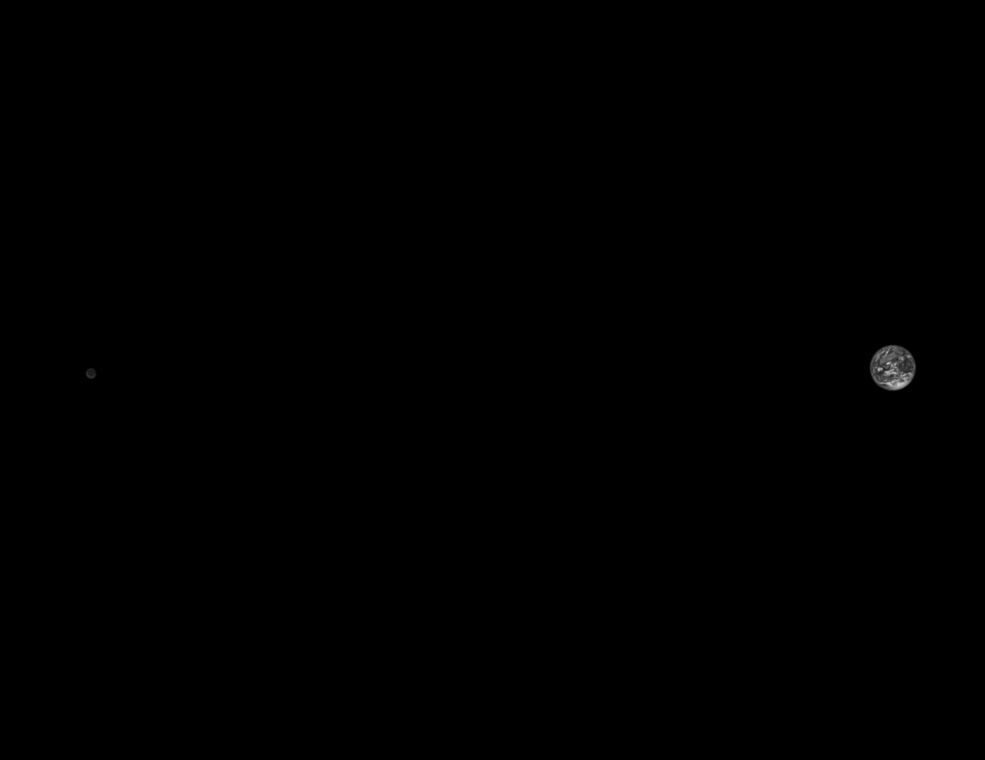
On October 13, 2022, NASA’s Lucy spacecraft captured this image of the Earth and the Moon from a distance of 890,000 miles (1.4 million km). The image was taken as part of an instrument calibration sequence as the spacecraft approached Earth for its first of three Earth gravity assists. These Earth flybys provide Lucy with the speed required to reach the Trojan asteroids — small bodies that orbit the Sun at the same distance as Jupiter. On its 12 year journey, Lucy will fly by a record breaking number of asteroids and survey their diversity, looking for clues to better understand the formation of the solar system.
The image was taken with Lucy’s Terminal Tracking Camera (T2CAM) system, a pair of identical cameras that are responsible for tracking the asteroids during Lucy’s high speed encounters. The T2CAM system was designed, built and tested by Malin Space Science Systems; Lockheed Martin Integrated the T2CAMs onto the Lucy spacecraft and operates them.
Credit: NASA/Goddard/SwRI
Quelle: NASA
----
Update: 29.10.2022
.
The moon is enchanting in new photos from NASA's Lucy asteroid mission

